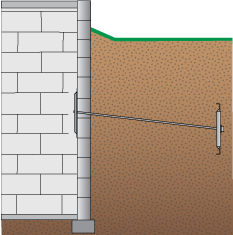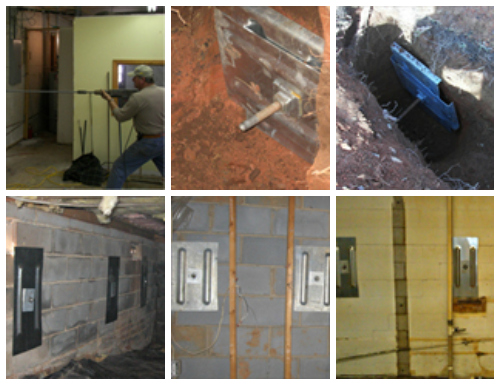If you notice a horizontal crack running along one of your basement walls and the wall is starting to push inward at the crack, you have a bowing wall. When you see the crack, several thoughts might go through your head: What is causing this? Is it serious? What’s the best way to fix it?
The short answers: Pressure is likely pushing in from the soil; yes, it is serious; and, well, it depends on the situation and extent of the damage. But let’s look at each of those questions in more depth.


Concrete and masonry foundations can fail over time, and walls can begin to bow. While some walls can start to fail due to poor design, bowing is usually caused by lateral pressure from outside soil or poor design. Walls can begin to bow because of compaction of the surrounding soil, pressures from freeze/thaw cycles, or poor drainage surrounding the foundation walls.
Oversaturated soil can put extreme pressure on foundation walls, so ensure that gutters and downspouts are draining correctly. Make sure that water is draining off nearby sidewalks, patios, and driveways and not pooling along the foundation.
Unfortunately, bowing walls are a serious structural issue and one that you should not delay getting repaired.
This is true for a couple of reasons. First, the more extensive the cracking becomes the weaker the wall gets. This means it will able to withstand the pressure even less going forward. Second, the worse the damage gets, the more limited the repair options become.
If left untreated, this problem could cause the wall to fail. There is a reason why horizontal cracks are usually listed as the most worrying of all foundation or basement wall cracks.
There are several methods. Some can be accomplished solely through work in the basement. Others necessitate excavations in the yard.
Let’s go with the worst case scenario first. If you leave the problem go for too long, the wall might be beyond repair and need to be rebuilt. And if no other corrective action is taken to fix what caused the bowing in the first place, you might end up right back where you started eventually. If you catch it in time, though, there are other options.
When it comes to repairs, those that operate solely in the basement tend to have the lowest impact on the rest of the property. The standard used to be placing steel I beams vertically at intervals along the wall to stabilize it, but recent years have seen a shift toward the material we use at Tar Heel: carbon fiber strips.
Carbon fiber when properly installed has a greater tensile strength than steel. It is thin enough that you can roll it, but strong enough that it can stabilize the bowing wall and prevent the issue from getting worse.
Strips of carbon fiber are placed vertically at intervals along the affected wall or walls. They are attached to the wall with a special epoxy and are anchored both above and below the wall.
The best part about carbon fiber is that it doesn’t intrude into your basement the way other wall repairs (such as the I beams) do. With the right kind of paint you can even paint over the carbon fiber, hiding the repairs from view.


As effective as carbon fiber is, there are times when another option is preferable. Maybe the wall has begun to sheer along the floor. Maybe the bowing has reached a point where the wall needs to be strengthened, not just stabilized.
Regardless, helical tiebacks and earth anchors both provide proven solutions to bowing walls as well. In both cases, the system has steel rods extending out form the wall underground to anchor the wall in the soil outside, providing a counter to the pressure pushing in on the wall.
Helical tiebacks use helical plates to anchor the wall, similar to how helical piers function. With plate anchors, after the anchor is sunk far enough out from the wall, a plate is attached to the end to prevent it from getting bulled toward the house by the bowing wall.
In each of these cases, some excavation likely will be needed outside the house. It does, however, allow for more straightening work to be done on the wall than carbon fiber.
A bowing or leaning wall is one of the most common foundation problems in our area.
Walls that are showing signs of movement are unstable and require some type of corrective action. Some devices monitor movement within the wall structure. Our experts can inspect your property and determine what needs to be done to remedy the situation and keep it from happening again.
Tar Heel Foundation Solutions has the right people and tools to get the job done effectively and quickly.
We’ll inspect your property for free and give you a quote on the work that needs to be done. Don’t let bowed walls become a foundation failure. The structural integrity of your building is at risk, however we are structural contractors that can make sure it is stronger than ever. Get in touch with us and let us send an expert to review your damaged wall situation and determine what we can do to help you solve any bowing or leaning that you have encountered.